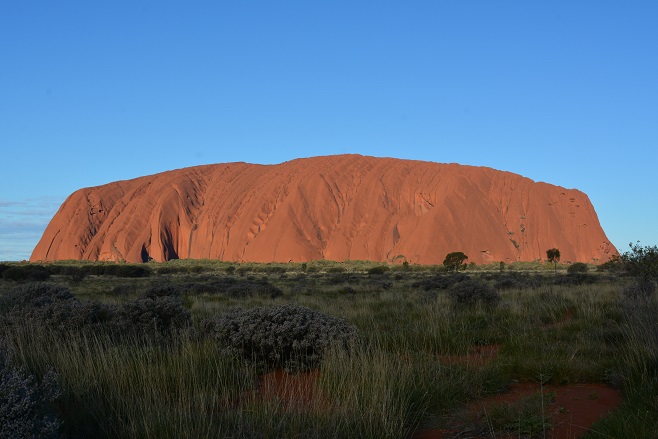
Visit the Iconic Landmark in the Red Centre of Australia
Uluru Ayer’s Rock
Updated Apr 2022
Uluru (formerly Ayer’s Rock) is Australia’s best-known geologic landmark. Located in the remote centre of Australia, it is now easy to get there by air or on paved roads. However, no tour of Australia is complete without a visit to the rock.
What is Uluru?
Uluru is not a mountain. It is a single rock or monolith. It is also an inselberg, a prominent natural feature sticking up in an otherwise flat terrain.
Uluru is made of aricose, which is a type of sandstone. It was compressed into rock over millions of years. At some point in time, there was an upheaval in the earth and the rock was pushed to the surface. Softer sand and dirt from around the rock washed away. What you see of Uluru today is like the tip of an iceberg, with the largest portion of it still beneath the surface, probably 3 km or more.
Uluru is about 3.6 km long (2.2 miles) by 1.9 km wide (1.2 miles) with a circumference of 9.4 km (5.8 miles)
Erosion
As you will see, Uluru today is full of holes caused by erosion. All that is needed is a small crack to start the process. After that, water gets into the gap, and eventually, a large chunk of rock will fall out.
Waterfalls
When it rains, and it does rain quite heavy at times, waterfalls appear on the sides of Uluru. There may not be any rain when you are there, but you can see where the water has eroded a series of depressions down the side of the rock.
Base Walk
You can walk around Uluru on an easy but long path. The path is a bit longer than the actual circumference of the rock, being 10.6 km in total length. However, this is a great way to spend a day at Uluru as it allows you to view all of it close up. Allow at least 3.5 hours.
Climb
People used to climb Uluru, but this has been prohibited since October 2019. This is because the local aboriginal people, called the Anangu, do not like people to climb it, as the rock is sacred to them.
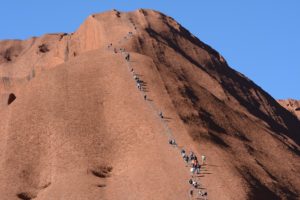
When we were at Uluru, we decided not to climb it, although it was still allowed at the time. There is nothing up there to see. It is very steep, and falling could be fatal. Falling off the rock has killed thirty-seven people.
It is far more interesting, safer, and less work to walk around the base. There are many things to see, such as rock formations, effects of erosion, plant, birds, and reptiles.
Things to do at Uluru
- Sightseeing. After getting settled in your accommodation, you will probably be anxious to see Uluru. It can be seen from the resort, but it is not so impressive from far away. You will want to get up close to appreciate its size and majesty. There is a paved road that goes around the rock.
- Visit the Cultural Centre in the park for information, interesting displays, and aboriginal culture. Aboriginal art and handicrafts are for sale there. (The information centre at the resort is mostly for booking tours).
- Take in the sunset. Uluru is most beautiful for a brief period at sunset. There is a special sunset viewing area. This is not to be missed. Go early if you want to set up a tripod, as sometimes it is crowded. (Make sure you go to the car sunset and not the one reserved for tour busses).
- The Base Walk is a 10.6 km hike all around Uluru. If you are fit, this is a pleasant hike. Long, but a flat, easy trail. Take plenty of water. If you prefer, you can rent bicycles at the Cultural Centre.
- The Mala Walk is a short, ranger-guided walk from the parking lot to the base of Uluru. The guide will explain the history of Uluru, the Anangu people, local wildlife, etc.
- The Mutitjulu Waterhole Walk is a short but pleasant and interesting walk to the base of Uluru.
- Many different tours can be booked at the information centre in the resort. These include camel rides, hot air balloon rides, sightseeing by aircraft and many more. (You can visit the camel farm at the resort).
- Each day at the resort, there are free displays of aboriginal culture, including dancing, music, storytelling and other activities. A free shuttle bus travels around the resort about every 20 minutes, including the campground. It does not go into the park.
Uluru Sunset
Although Uluru is amazing at any time, it is spectacular at sunset and sunrise. So be sure to plan your time to take in at least one of them.
Facts
Accommodation, both hotel and camping, is available at nearby Ayers Rock Resort, just outside the park’s gate.
The entrance fee to the park is $25 per person for a three-day pass. There are no one-day tickets.
Services are limited. There is one fuel station and a small grocery store, but there is no pharmacy.
The resort has a small airport.
There are car rentals available for people who arrive by air.
The nearest city is Alice Springs, which is about 465 km away to the northeast.
Kata Tjuta
Kata Tjuta is another inselberg, about 50 km away. It was once a single rock like Uluru but has since broken into 36 separate dome-shaped rocks. There are interesting hiking trails in the gorges between the rocks, but some are difficult. For example, the Valley of the Winds walk is rugged, and you must start before 11 a.m at the latest (you should begin as early as possible to avoid the heat of the day and allow time for rest or problems). The trail is closed at 11 a,m or when the temperature exceeds 36 degrees Celsius.
Mt Conner
The flat-topped Mt Conner is another inselberg you will see if you are driving to Ayers Rock Resort. Many people think they are getting their first glimpse of Uluru, but Mt Connor is flat on top, and Uluru is rounded. Mt Conner is on private land, but tours can be arranged at Curtin Springs Roadhouse nearby.
This information was correct at the time of writing, but things are constantly changing. Check with your resort for the latest information.

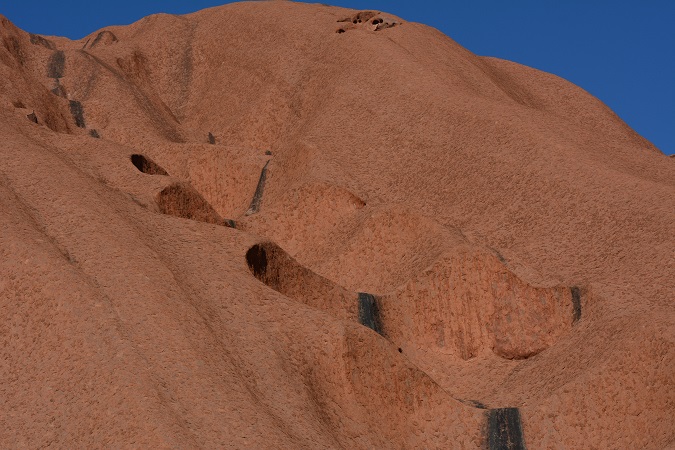

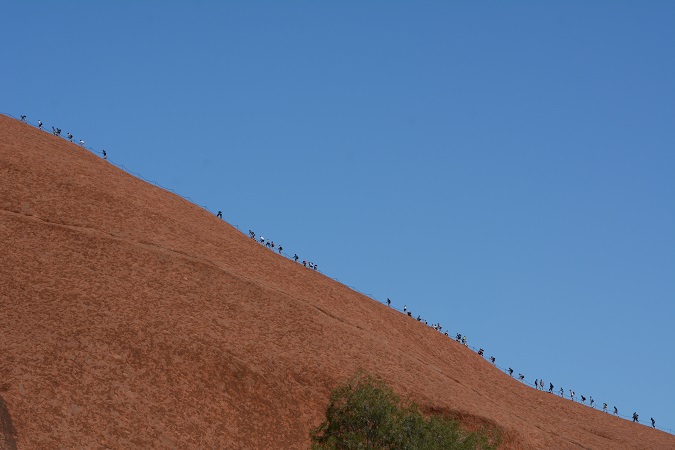
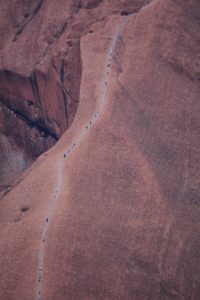
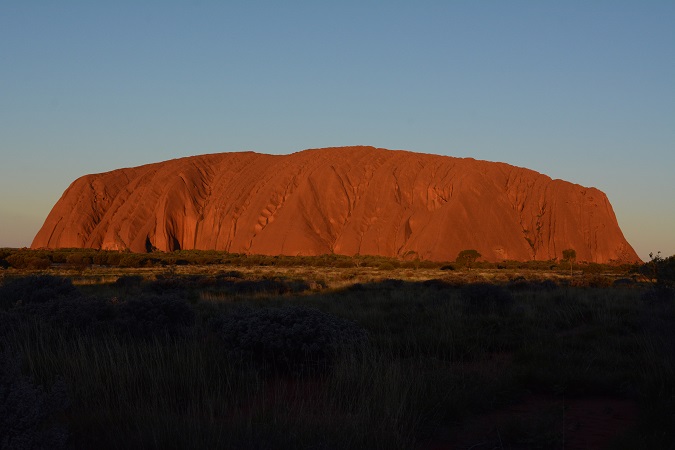
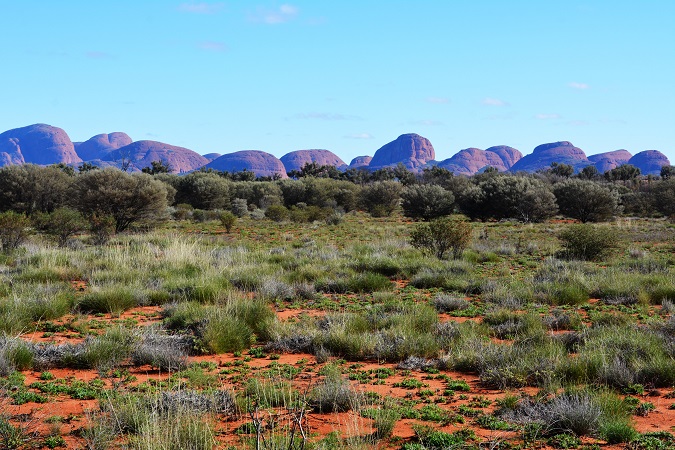

Tom, a very informative post. Great pictures of both Uluru and the surrounding countryside. If it is so susceptible to erosion then perhaps a ban on climbing is what is needed to help preserve the site.
Anyway looks like your Australian adventure is going well and is lots of fun. Safe travels.
Thank you Tim. The rangers at the park say that they plan to close the climb sometime in the future. But the whole rock is eroding due to exposure to the elements, rain, wind, etc. This is a natural process. Sorry to take so long in answering but there is a lack of places to use the internet while travelling in Australia.
As always great presentation
Thank you Daryl.